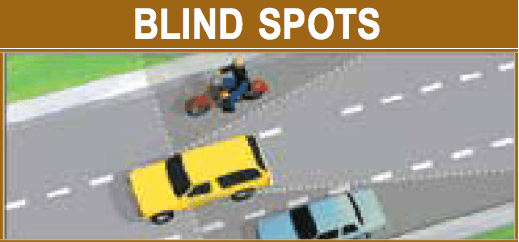Changing Lanes
Lane Choice
Note the importance of choosing the lane that is appropriate for the driving action, such as turning or parking.
Drive in the lane with the smoothest flow of traffic. For example, if a roadway has 2 lanes in the same direction, select the right lane. If they can choose among 3 lanes, pick the middle lane. To drive faster, pass, or turn left, use the left lane.
Lane Changes
You may discover your teen has difficulty changing lanes in a smooth, continuous movement. Have your teen follow the steps below to make sure that a lane change is made safely:
- Signal.
- Check the traffic ahead.
- Look in the mirrors for breaks in the traffic.
- Check their blind spot by looking over their shoulder into the lane they wish to occupy.
- Change lanes by moving into a break in traffic flow.
- Steer to center the vehicle in the new lane.
- Turn off the signal.
Problems to Watch for:
- Failing to check the rearview mirror.
- Failing to look over their shoulder at blind spots.
- Checking over their shoulder too long while the vehicle drifts from its path or gets dangerously close to vehicles ahead.
- Not knowing if there is enough room to change At first, you should make the judgment for your teen. When your teen is able to look over their shoulder and still stay in the lane, have your teen tell you when it is safe to change lanes. Continue requiring a verbal check until you agree with their decision.
Keeping Space Around the Vehicle
Most drivers do not see “the big picture” as well as they should because they follow too closely, and the vehicle ahead blocks their view of the road.
Good drivers maintain a safe following distance to see more of what is happening in traffic. The more distance they allow between their vehicle and the vehicle ahead, the more time they will have to see a hazard or collision down the road. They will have more time to stop, or to avoid the problem.
Encourage your teen to keep enough distance between their vehicle and the vehicle ahead, to the sides, and to the rear. Your teen will then have a “bigger picture” of their driving environment. Steering will be easier and the vehicle can travel in the center of the lane instead of hugging one side of the lane or the other.
Teach your teen how to keep at least a three-second following distance. When the vehicle ahead passes a signpost or other object near the road, count “one thousand one, one thousand two, one thousand three.” If you pass the selected object before completing this count, you are too close.
When crowded by a tailgater, your teen should allow extra room between their vehicle and the vehicle ahead. Allowing more following distance gives them and the tailgater more time to react in an emergency. “Lose” the tailgater as soon as they can. Have your teen change lanes and allow the tailgater to pass them, or slow down to allow enough space between them and the vehicle in front of them. If this does not work, have your teen pull off the road when it is safe and let the tailgater pass.
If another driver closely changes lanes in front of them, it is better to just take their foot off the gas. This will give your teen space between their vehicle and the other vehicle without swerving into another lane. Do not overreact in this situation.
Tell your teen to avoid driving in the blind spot of other drivers. The other driver may not see your teen’s vehicle and could change lanes, causing a collision.
